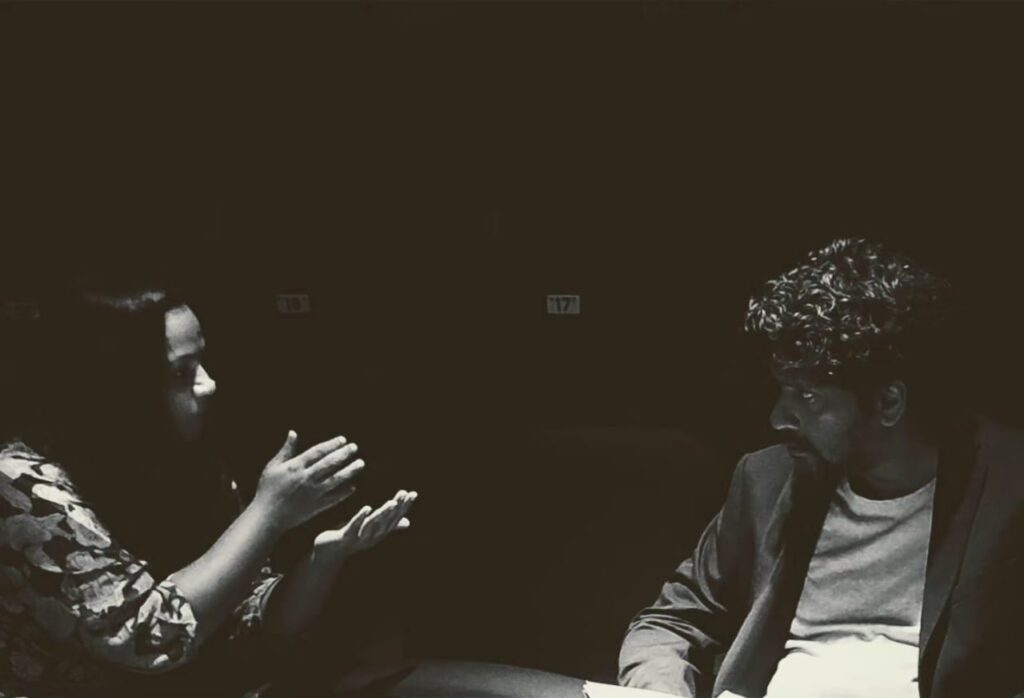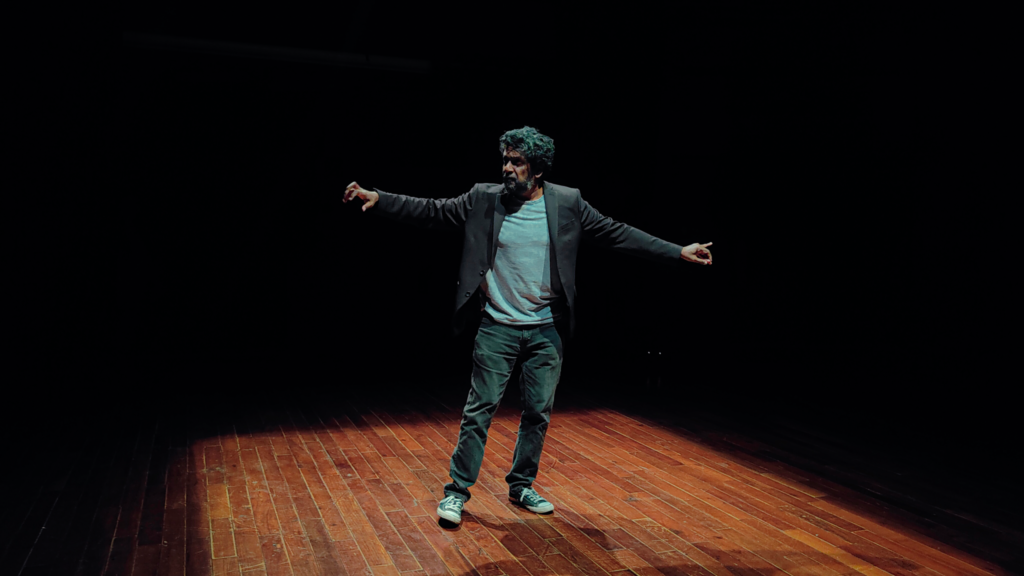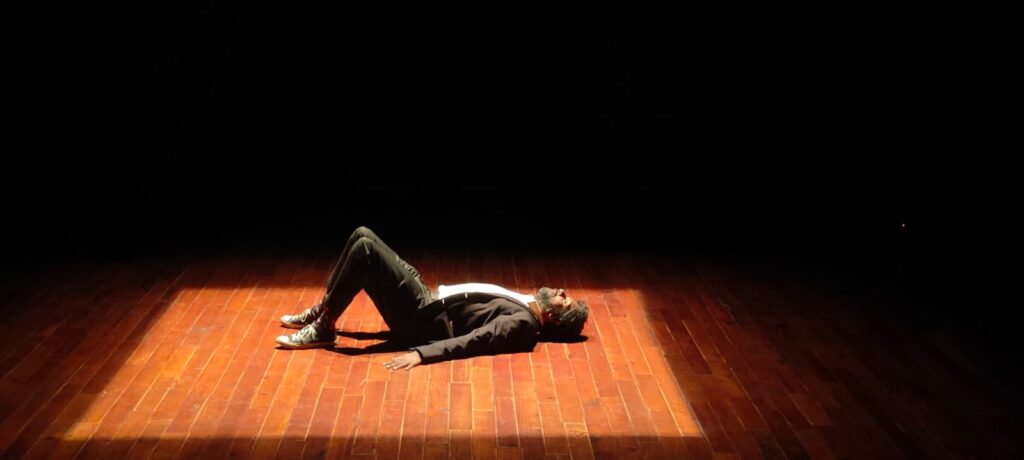Director’s Note

“For me, a play is the result of a journey. As a director, I find myself focussing on what happens in the making of a piece, how the show is made, how space is held in the rehearsal room, how the process allows us to travel from ourselves towards the playing of a character and the telling of a story, with truth.
I cannot imagine taking this journey to make Thom Pain (based on nothing) with anyone except Preetam Koilpillai who I immensely trust and with who I share great creative synergy.
This play is, for me, a play about truth. The truth of one’s life, the quality of one’s existence and the banality of lived experience. Thom Pain is a cheery man in the middle of an existential crisis, attempting to locate his part, his participation in the many experiences that define him. This play asks us who we are and if we’re not a sum of our experiences, then certainly we must be a victim of circumstance. I find this play and this character to be so complex to portray because he, like many of us, is just trying to make it work and make sense of his day. In this attempt, he stumbles messily on new pain and old love. What is Thom Pain expected to do? What are any of us expected to do when we all have to show up, patched up ready to roll up our sleeves to live through another day? Maybe we cope, maybe we survive, maybe we don’t.
In rehearsal, I wanted us to find truth and locate our performance in a space, in a body that was at its core, honest. When the demands of this pursuit were immensely hard, I watched Preetam dig deeper than I thought possible to find the truest version of language, physicality and space. The character and performance that has emerged is richer for it. When the process was tough and exacting, Preetam and I promised each other to work till we had given it everything, holding nothing back, seeking only the absolute essential in our performance choices.
At several points in rehearsal, we drew from who we are as people, the way we live our lives as a way to make our art as authentic as possible. I believe we tried our best.
I consider it a great privilege to have held this space with my actor, to witness the vulnerability that was offered with such generosity towards making a story, a character, a possibility come alive.
I believe we have made this play as a response to the space we held, the truths we shared and our conviction that art first needs to transform the people who make it so that it can stand and deliver a measure of truth to its audience.
It is my belief that the journey we have made can be witnessed on the stage.”
– Rebecca Spurgeon
Actor’s Note

“Two things made me very keen to work on Will Eno’s Thom Pain (based on nothing). The first was Rebecca’s initial character description over the phone, a “stray dog sort”, or something to that effect, and the second was the opportunity to work with her. Rebecca and I have been friends for many years and we’ve tangled before as actors, but never as director and actor. I saw this as an opportunity to learn something from her. This was very important to me.
Beyond the opportunity, Thom Pain is a solid challenge. It’s a solo performance with a complex and deeply personal script that pushes its performer to the edges of survival, physically and mentally. The first pressure point was memory. Memorising so many pages of thoughts, feelings and memories, all of which are juxtaposed against each other at the oddest angles, is tough. Hopefully, by the time you’re reading this, it’s all there. Or nearly there. For your sake and mine. The second pressure point was to work the detail and precision that a director like Rebecca demands. This brought a rigour to our work that pushed me and continues to push me to be more meaningful and truthful in what I say and do. The ‘truth’ has always been our guiding star. The third pressure point was to fully inhabit the character of Thom Pain. He and I share many things. Too many, I think. But it helps. It helps understand the truth of Pain, his fears and anxieties, that so closely mirror mine, ultimately forcing me to confront the difficult memories from my own past. Perhaps this was why Rebecca asked me in the first place. Perhaps she knew. I suppose it’s all left to be seen. Anyway, to quote Thom Pain, “If I were you, I’d be sick of this already”.
Till later then.”
– Preetam Koilpillai
Production Design Notes

“Thom Pain (based on nothing) has proved to be quite a departure for me with respect to how I normally approach set & light design. In rehearsal it became evident that the most truthful version of visual was to allow the text and the actor to keep the focus and for the actor to remain the lasting visual of the play. Initially I created various design options that can help enclose the space – different structures and textures that could achieve this. But as the play started coming together and the show started emerging, everything additional started to feel too intrusive to the story and the character that I wanted to remain with.
When you watch the show, it’s likely that you will see no “set” because well, there isn’t a physical structure of any manner on stage. But in reality there is a set, a space, a definition within which the character stands and moves. A construction of his own, a boundary from which he doesn’t feel permission to leave.
If I had designed a set for this play some years ago, earlier in my career, I would not have imagined the space or seen the meaning this way. I might have wanted to underscore the intent. Making sure the audience only sees the space in a particular way. But now, I am more excited and driven by the sculptural nature of space. The way space needs a person to respond to it in order to arrive at its meaning. This idea of a set, the meaning of how visuals have to be extensions of the self, the mood, the tone of the play is how I finally approached the design choices for Thom Pain (based on nothing). A set, now for me, is a weighted space. What physical structures and the actor’s body do to integrate – adding movement or limiting space is an exciting possibility to explore in rehearsal. My idea of what space means to me has been greatly influenced by how I think and feel as an actor and director. I rarely, if ever, think of the set and the character as separate. To me, in this play, the set is a very structured, very uniform box that the character Thom Pain tells his story from. It had to be structured and symmetrical because the stories he tells us are, in a word, messy – life is messy and his life certainly is. The contrast of clean lines against a character who is struggling to keep a linear narrative was interesting to me. It was also important to me to have him always stay in this box, a box of his making that is both constricting and yet comforting in the way the familiar always is.
I almost always design lights when I design sets. This is because when I design a visual I always imagine it in a specific light and how that space will change and evolve in illumination or shadow. I think it would have been impossible for me to imagine this performance space for the character, Thom Pain, without thinking about how the light would hold that space, define it and him. Working in a theatre like Jagriti is great for this particular kind of design because it allows for close sharp angles and immense intimacy. I also love sharp angles that allow us to see, at various points, a simultaneous shadow and fully lit image. That’s very interesting to me personally because I’m drawn more to the darkness, the silence and negative space in performances. In making this show, I think I made the show and created the visuals that really first moved me.”
– Rebecca Spurgeon

